Curious about the differences between Mahi Mahi vs Salmon? These are two popular fish that are as delicious as they are healthy. However, learning how to choose the best quality fish for your family is important.
Jump to:
These two delectable options grace our plates with their exquisite flavors and offer numerous health benefits.
Mahi Mahi and Salmon happen to be two of our family's favorite fish to eat. We also love halibut, pollock, cod, tuna, and flounder!
Our young children are definitely fish lovers, and it's a good thing too! High-quality wild-caught fish are rich in healthy fats, omega fatty acids, and essential nutrients, and are a good source of protein.
These unique attributes help support brain function and development which is especially important for pregnant women and children!
What is Mahi Mahi
Mahi Mahi, also known as Coryphaena hippurus, is a versatile and sought-after type of fish that hails from the warm waters of the Gulf of Mexico and other subtropical and tropical regions.
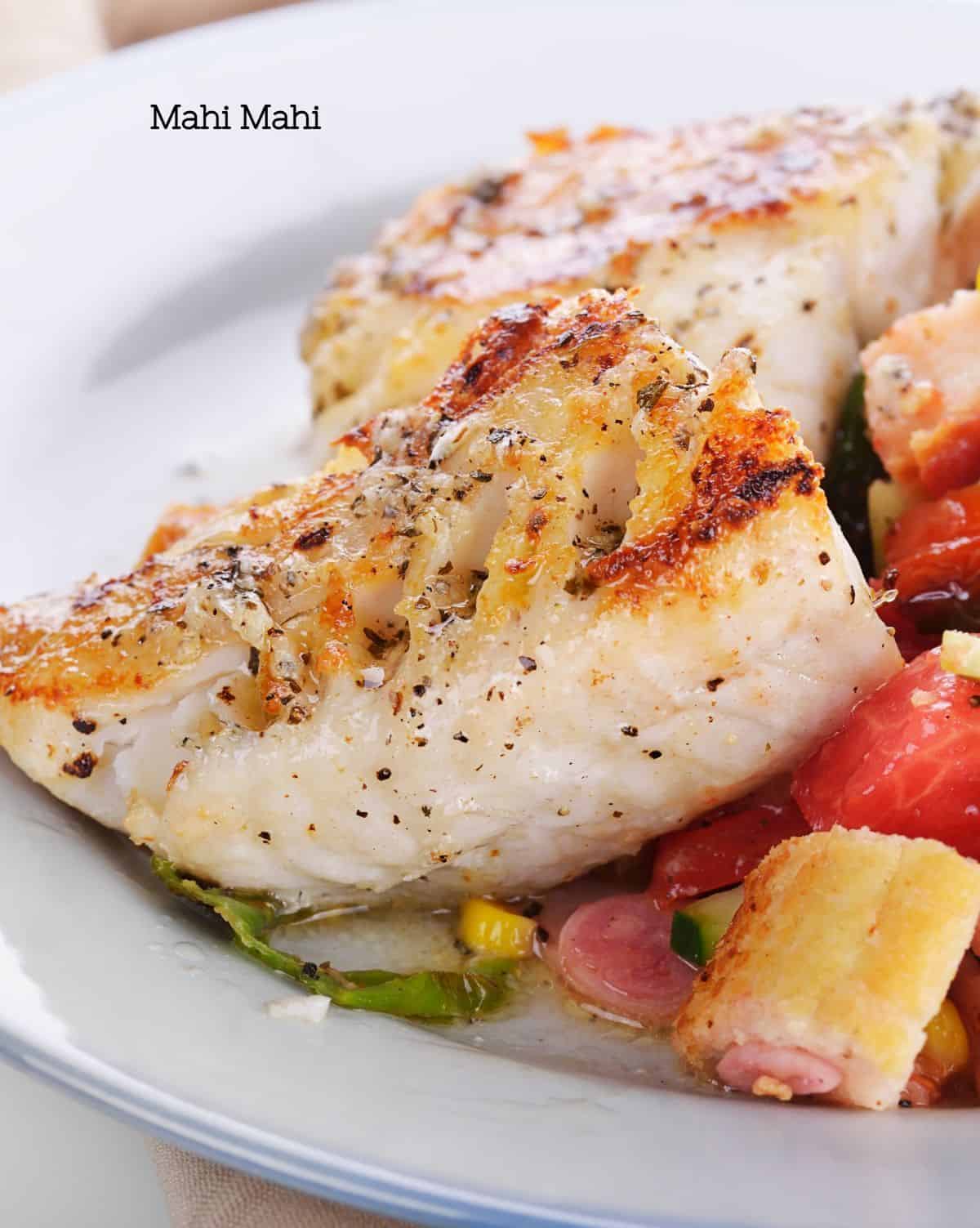
This fish, often referred to as "dolphin fish" (not to be confused with the marine mammal), is prized for its unique qualities and excellent taste.
Mahi Mahi Taste
One of the standout features of Mahi Mahi is its sweet and delicate flavor. This makes it a favorite among seafood lovers who appreciate white fish with a mild, yet distinct taste. It works well on tacos, salad, or a standalone entree.
In fact, the sweet and flaky texture of Mahi Mahi's lean flesh lends itself perfectly to a wide variety of culinary preparations, making it an excellent choice for those seeking both flavor and health benefits.
A Healthy Choice
The Mahi Mahi fish isn't just delicious; it's also a healthy choice for overall well-being. This fish is a good source of omega-3 fatty acids, which are known for their positive impact on heart health.
These essential fatty acids can help lower cholesterol levels and promote a healthy weight. However, Salmon tends to be higher in fat than mahi.
Nutrient-Rich
In addition to omega-3s, Mahi Mahi has a rich essential amino acid profile, which is vital for energy production and overall health.
Its nutrient profile includes vitamins and minerals that support various bodily functions, making it a delicious fish that contributes to your overall vitality.
Cooking Mahi Mahi
Cooking Mahi Mahi is a delightful culinary experience. Whether grilling, baking, pan-searing, or air-frying Mahi, its versatility shines through in a variety of dishes.
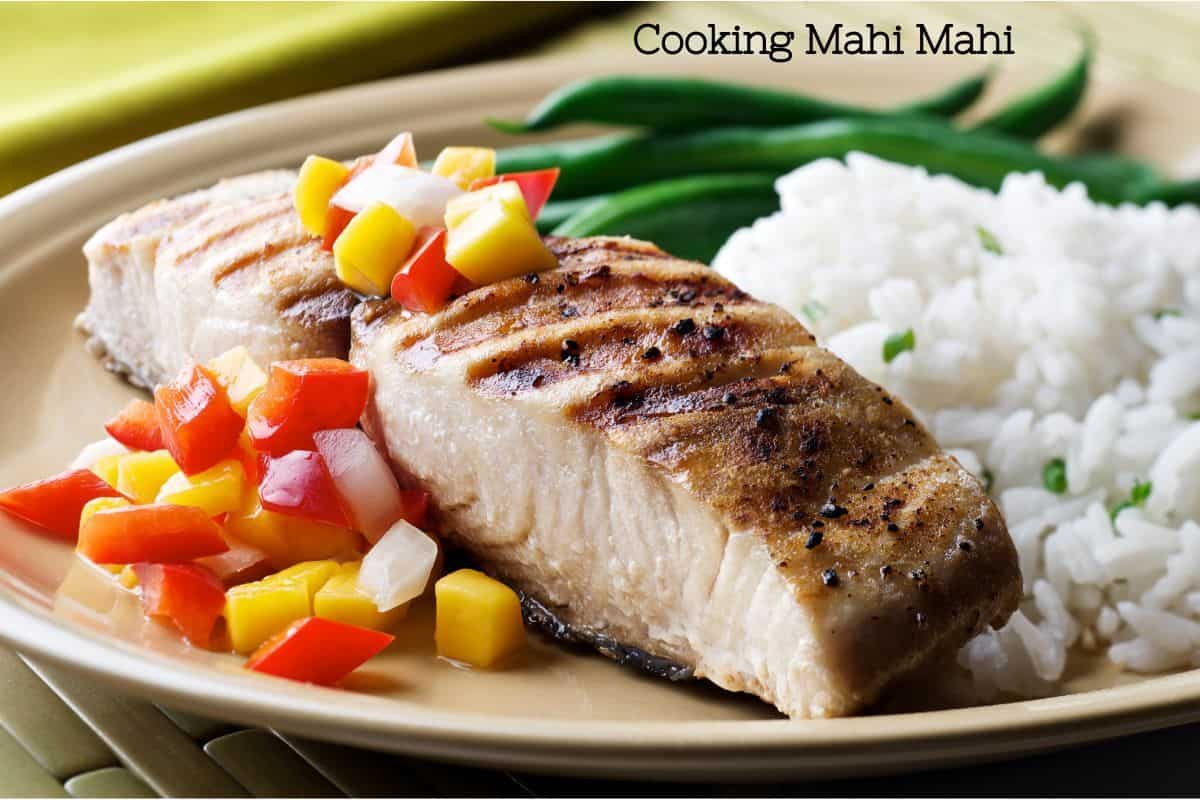
The delicate flavor of Mahi Mahi pairs well with a range of seasonings and sauces, allowing you to get creative in the kitchen.
Wild-Caught Mahi Mahi
For the best Mahi Mahi experience, seek out wild-caught fresh fish from reputable sources. Fresh Mahi-Mahi captures the essence of its warm-water origins, delivering a delightful taste that truly elevates your seafood dishes.
In the right regions, you should be able to find fresh mah-mahi in local markets.
However, frozen mahi is just as nutritious and delicious. The most important thing to consider when searching for Mahi Mahi is that it is wild-caught.
Wild-caught fish are the best as they have not been subjected to the poor diet and conditions of concentrated fish farms. In fact, farmed fish are dangerous and carcinogenic.
 Wild-Caught Mahi-Mahi Porti...Shop on Amazon
Wild-Caught Mahi-Mahi Porti...Shop on Amazon
What is Salmon
Salmon, a popular choice, is a remarkable species of fish known for its distinctive characteristics and rich flavor.
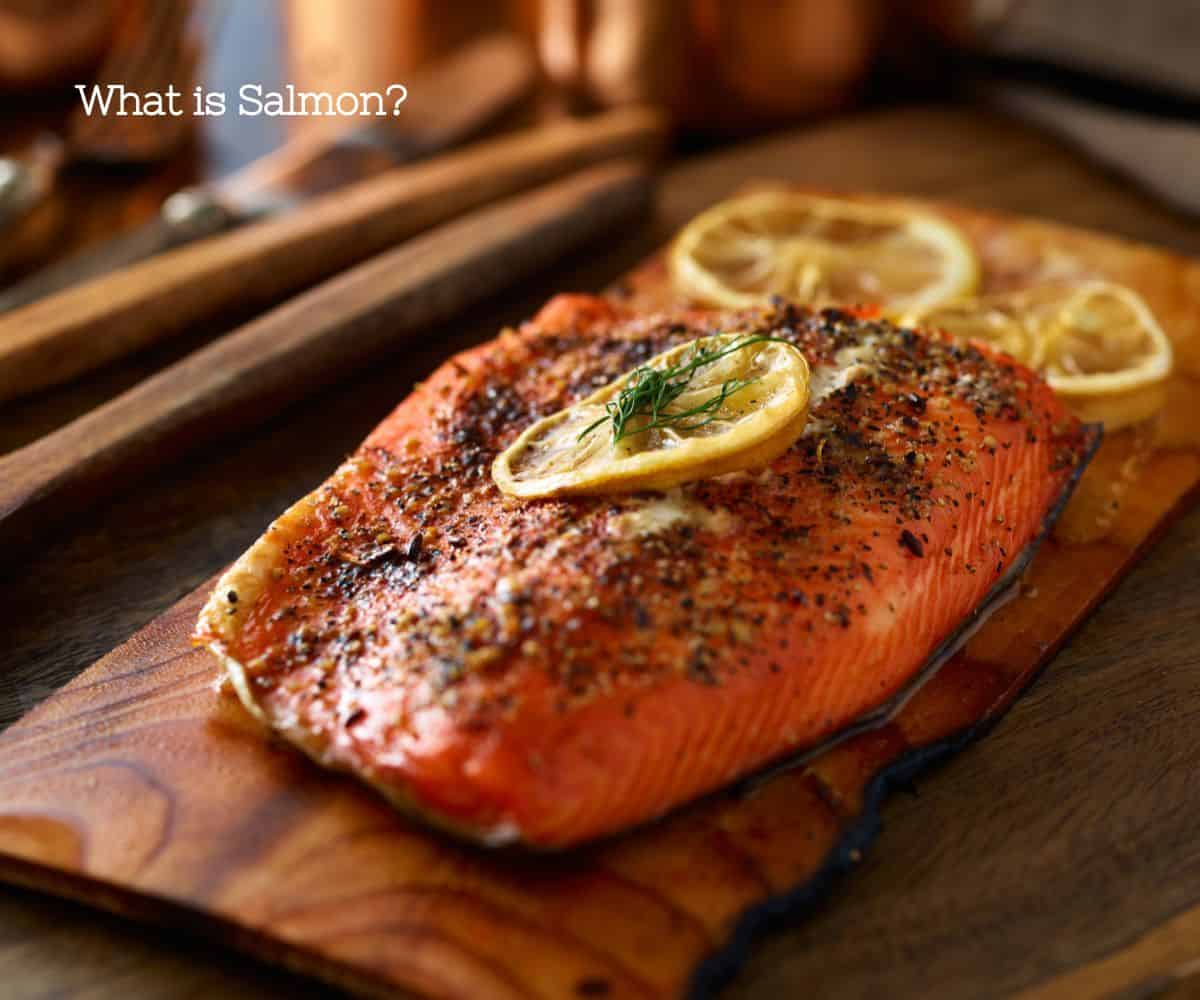
This firm-textured fish comes in various species, with Atlantic salmon (typically farmed) and wild-caught salmon (usually Alaskan sockeye salmon), being some of the most well-known.
Salmon Taste
Salmon offers a rich and distinctive flavor that sets it apart from other fish species. Its taste can range from mild to robust, depending on the type of salmon.
King salmon, for example, is celebrated for its excellent flavor and firm texture.
Nutritional Powerhouse
Salmon is not just a tasty fish; it's also an excellent source of essential nutrients. Packed with B vitamins, it plays an important role in supporting various bodily functions.
Additionally, salmon is renowned for being an excellent source of protein. See the chart below foe nutritional content!
Wild-Caught Salmon
When choosing salmon, wild-caught varieties, particularly sockeye salmon are best.
Wild-caught salmon is prized for its delicious flavor, natural origins, and lower environmental impact compared to farmed salmon.
Sockeye salmon, in particular, is among the most common wild-caught salmon species, and it's celebrated for its deep, rich flavor and vibrant red flesh.
In fact, you can easily tell the difference in color and patterns between farmed salmon vs wild salmon.
The next time you are in the grocery store, check out the fresh fish section. The farmed salmon is a faded pink with wider stripes.
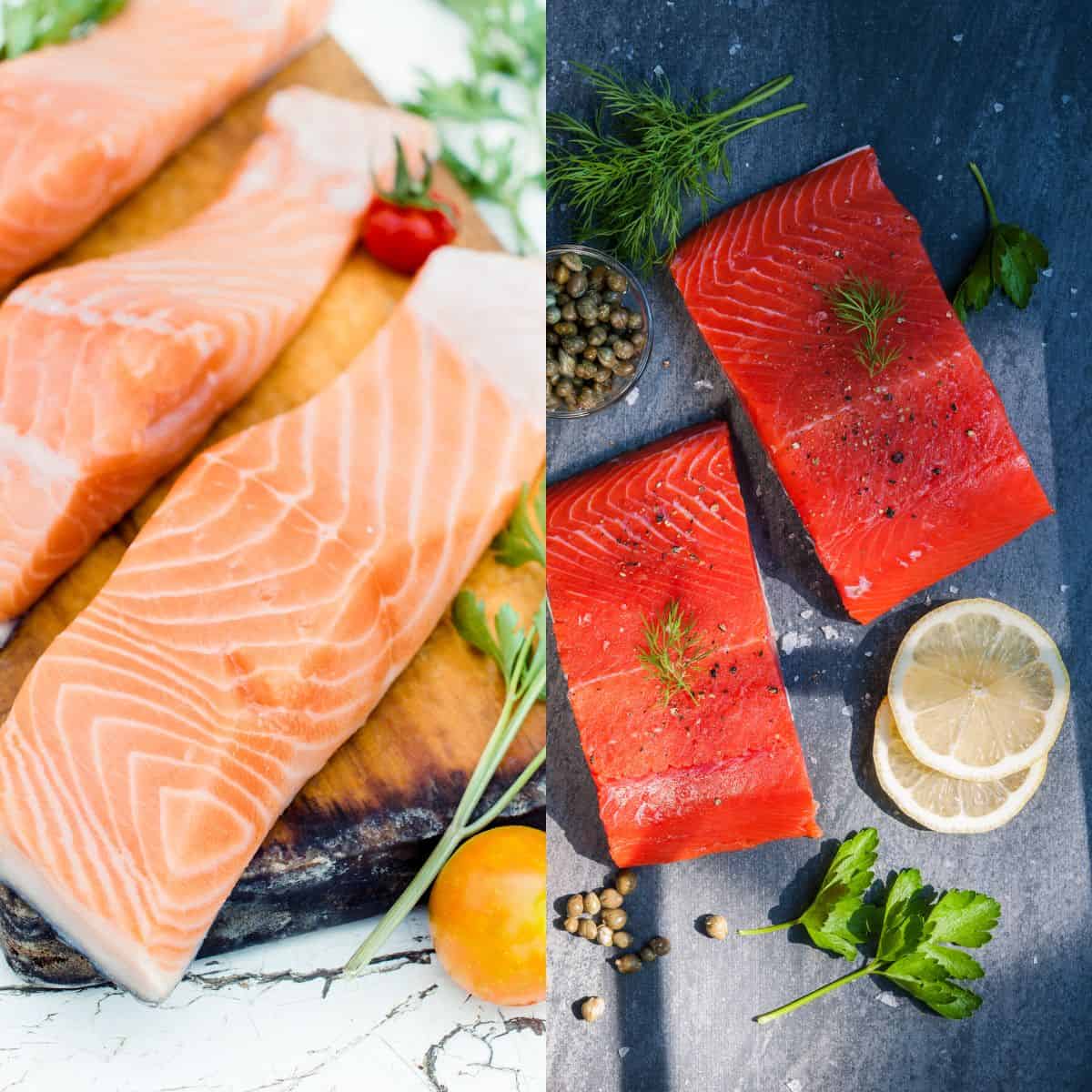
In fact, it is naturally grey due to the poor conditions they are grown and the awful diet and antibiotics used.
To make the farmed versions pleasing to the eye, they use additives to dye the fish.
These farmed fish are studied well now and are known to increase the risk of cancer by 80% if you consume them regularly! Check out our diet that excludes processed foods, ingredients to avoid, and anti-cancer diet guides to learn more!
Always, always, always opt for wild-caught fish.
Omega-3 Fatty Acids
One of the standout benefits of salmon is its high omega-3 fatty acid content. These heart-healthy fats have been linked to a reduced risk of heart disease. The American Heart Association recommends including salmon in your diet as an oily fish that can help improve cardiovascular health.
Moderate Mercury Levels
Wild-caught salmon is generally considered a safe choice due to its moderate mercury levels, making it suitable for semi-regular consumption.
This is particularly important for those who want to enjoy the benefits of seafood while minimizing potential risks associated with mercury exposure.
Cooking with Salmon
Salmon's versatility in the kitchen is another reason it's a popular choice. It can be prepared in a multitude of ways, from grilling and baking to poaching and pan-searing.

Its firm texture holds up well to various cooking methods and seasonings, allowing you to create an array of delectable dishes.
 Amazon Grocery, Wild Caught...Shop on Amazon
Amazon Grocery, Wild Caught...Shop on Amazon
Comparing Mahi and Salmon
Let's compare these two fish in terms of their nutritional content, availability, taste, culinary uses, cost, location, size, ease of cooking, and considerations for novice users.
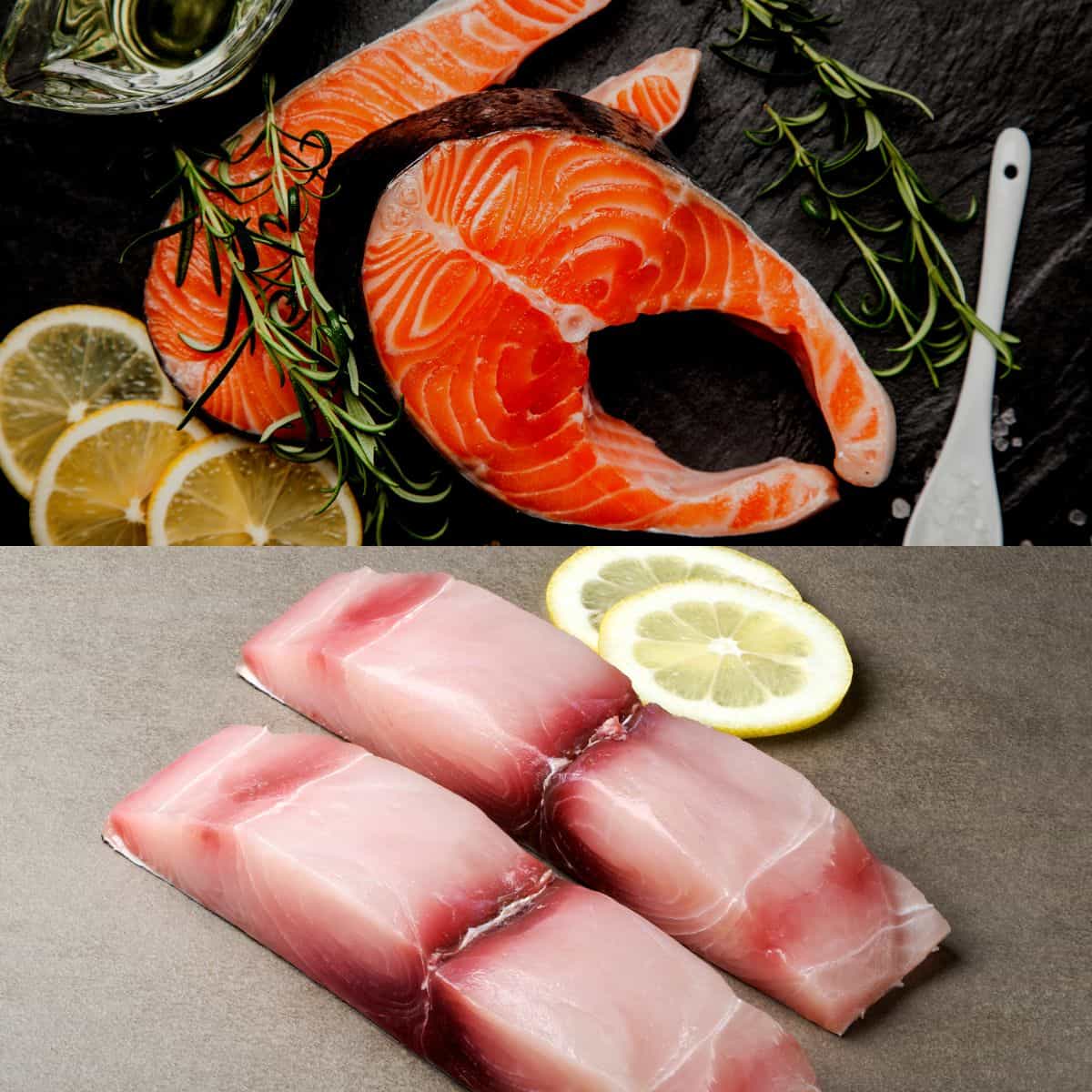
Nutritional Content and Benefits
- Mahi Mahi: Mahi Mahi is a lean fish with low fat content. It's an excellent source of protein and provides essential nutrients. It's rich in vitamin B, particularly B6 and B12, which play important roles in energy production.
- Salmon: Salmon, on the other hand, is known for its higher fat content, particularly in the form of heart-healthy omega-3 fatty acids. It's an excellent choice for those looking to boost their omega-3 intake and support heart health.
Availability and Location
- Mahi Mahi: Mahi Mahi is often found in tropical and subtropical waters, including the Atlantic Ocean and the Indian Ocean. It's commonly available in regions where these waters are accessible.
- Salmon: Salmon has a broader distribution, with the Atlantic and Pacific oceans being its primary habitats. Salmon is widely available and can be found in many parts of the world.
Taste and Culinary Uses
- Mahi Mahi: Mahi Mahi has a mild, slightly sweet flavor with a delicate texture. It's versatile and pairs well with a variety of seasonings, making it suitable for grilling, baking, or pan-searing.
- Salmon: Salmon offers a distinctive, rich flavor and firm texture. It's often preferred for dishes that benefit from its robust taste, such as grilling, smoking, or broiling.
Cost
- Mahi Mahi: Depending on season and region, Mahi Mahi tends to be slightly more budget-friendly compared to salmon.
- Salmon: Salmon can be pricier due to its higher demand and limited availability in certain regions.
Size
- Mahi Mahi: Mahi Mahi is a relatively large fish, and its fillets can vary in size, making it suitable for various cooking methods.
- Salmon: Salmon is typically also a large fish, but comes in different species and sizes, offering options for individual preferences and portion sizes.
Ease of Cooking
- Mahi Mahi: Mahi Mahi is easy to cook and forgiving for novice chefs. Its mild flavor allows for experimentation with different seasonings and cooking techniques.
- Salmon: While salmon is versatile, its rich flavor can be intense for some palates. Novice cooks may find it beneficial to start with milder fish varieties. Be careful not to overcook! It becomes crumbly if it is overcooked.
With either fish, it is important to keep and eye on it and use a fork to test for flakiness.
Bones
- Both Mahi Mahi and Salmon may have bones that need to be removed before cooking or serving. This is a common step when preparing these fish.
In conclusion, both Mahi Mahi and Salmon offer nutritional benefits and are excellent choices depending on your preferences and dietary goals.
Mahi Mahi's mild flavor and affordability make it a versatile option, while Salmon's omega-3 content and distinct taste are preferred by many.
Consider your location, taste preferences, and cooking skills when making your choice, and don't forget to check for bones before cooking.
It is best to eat a variety of foods, including fish. If you enjoy the flavors of each of these fish, alternate them throughout your monthly meal rotations. Happy cooking and bon appétit!
 365 Everyday Value, Wild-Ca...Shop on Amazon
365 Everyday Value, Wild-Ca...Shop on Amazon
 Amazon Fresh, Wild Caught M...Shop on Amazon
Amazon Fresh, Wild Caught M...Shop on Amazon
Nutrition Table Comparison
| Nutrient (per 3 oz/85g cooked portion) | Mahi Mahi | Salmon |
|---|---|---|
| Calories | 85 | 175 |
| Protein (g) | 17 | 20 |
| Total Fat (g) | 0.6 | 10 |
| Saturated Fat (g) | 0.1 | 1.5 |
| Omega-3 Fatty Acids (mg) | 100 | 1200 |
| Vitamin B6 (mg) | 0.2 | 0.5 |
| Vitamin B12 (mcg) | 0.6 | 2.4 |
| Selenium (mcg) | 35 | 21 |
| Phosphorus (mg) | 196 | 218 |
| Potassium (mg) | 331 | 379 |
| Iron (mg) | 0.2 | 0.3 |
Note: Nutritional values may vary slightly depending on the specific type of fish and cooking method.
FAQ
Nutritionally, each of these fish is incredibly healthy and nutrient-dense food. Mahi is a leaner option with less calories and fat, while still boasting essential vitamins and minerals. Meanwhile, Salmon is one of the best sources of omega-3 fatty acids that is amazing for skin, hair, heart, and brain health. Both of them are incredibly healthy sources of protein when choosing wild-caught fish.
Many people believe mahi tastes delicious due to its mild and slightly sweet flavor and light and flaky texture. It is complimented well with a variety of seasonings and sides.
Mahi is a light and flaky white fish that is similar in texture to halibut or cod, although cod is slightly more moist. If a recipe calls for any of these fish, it can seamlessly be swapped for another white fish.
As you can see, Mahi Mahi is lower in calories, total fat, and saturated fat compared to Salmon. It's also a good source of protein and provides essential vitamins and minerals, particularly vitamins B6 and B12.
However, Salmon shines as an excellent source of heart-healthy omega-3 fatty acids, providing significantly higher amounts than Mahi Mahi. Additionally, Salmon has a higher calorie and fat content due to its omega-3 richness.
Your choice between Mahi Mahi and Salmon should align with your dietary goals and flavor preferences, as well as consider factors like cost and availability.
Are you a fish lover like us? Which is your favorite fish? Let us know in the comments below!
Be well,
Natalie

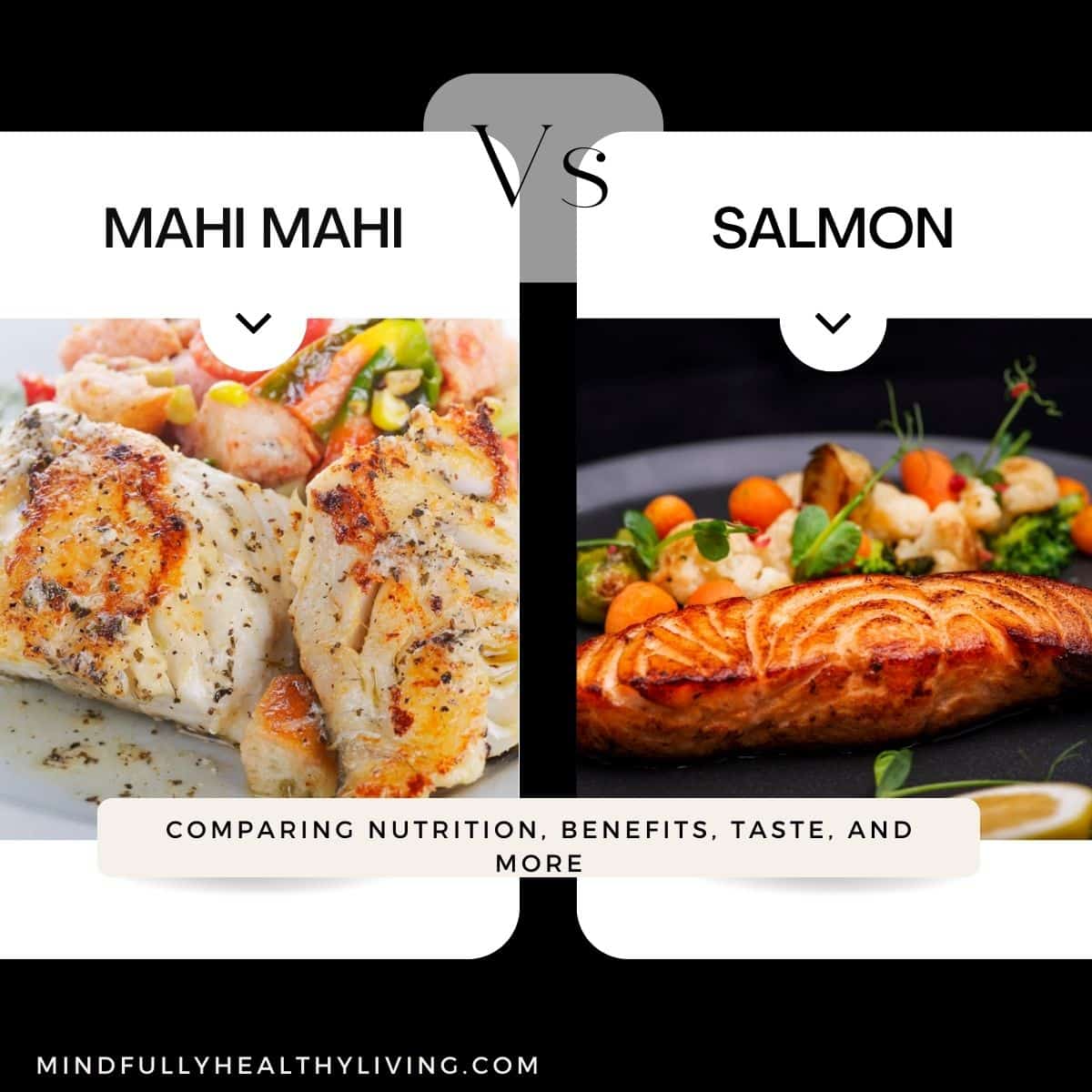
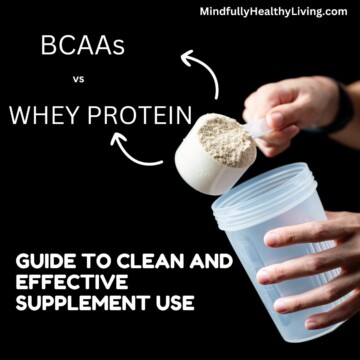
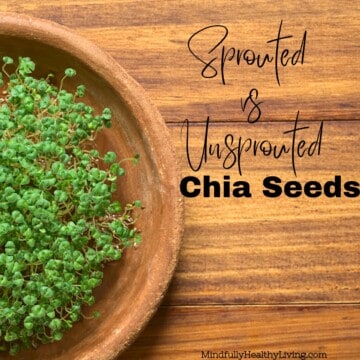
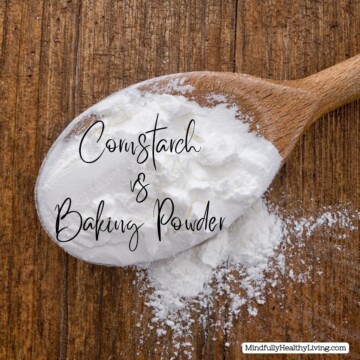


Comments
No Comments